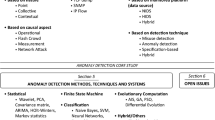Abstract
Security must be provided in VANET as it is open to various attacks due to malicious vehicle, Brute force attack, misbehaving and faulty nodes, malicious users, and malicious nodes. The attacks can be occurred due to the lack of authentication. To overcome this problem, in this paper, we propose to develop a group key authentication and misbehaviour detection in VANET. Initially, we form clusters with three types of nodes within a certain transmission range namely Unique Node, Sub Unique Node, and Normal Node. Handshaking can be performed followed by message signing. The message is verified, and then group key is generated with subsequent key generation at each time slot. Finally, location information and time about vehicles can be used to detect malicious behaviours. Simulation results show that the proposed technique can achieve more packet delivery ratio with reduced delay, overhead, and packet drop.










Similar content being viewed by others
References
Chhoeun, S. A., Ayutaya, K. S. N., Charnsripinyo, C., Chamnongthai, K. ,& Kumhom, P. (2009). A novel message fabrication detection for beaconless routing in VANETs. In International conference on communication software and networks (pp. 453–457).
Raw, R. S., Kumar, M., & Singh, N. (2013). Security challenges, issues and their solutions for VANET. International Journal of Network Security & Its Applications (IJNSA), 5(5), 95–105.
Kumar, A., & Sinha, M. (2014) Overview on vehicular ad hoc network and its security issues. In International conference on computing for sustainable global development (pp. 792–797).
Wei, L., et al. (2014). Security and privacy for storage and computation in cloud computing. Information Sciences, 258, 371–386.
Hwang, R.-J., Hsiao, Y.-K., & Liu, Y.-F. (2011) Secure communication scheme of VANET with privacy preserving. In IEEE 17th international conference on parallel and distributed systems (pp. 654–659) (ISSN: 1521-9097).
Mershad, K., & Artail, H. (2011) REACT: Secure and Efficient Data Acquisition in VANETs. In IEEE 7th international conference on wireless and mobile computing, networking and communications (pp. 149–156) (ISSN: 2160-4886).
Wei, L., et al. (2010) SecCloud: Bridging secure storage and computation in cloud. In ICDCS workshops (pp. 52–61).
Yan, Z., et al. (2014). A survey on trust management for internet of things. Journal of Network and Computer Applications, 42, 120–134.
Jing, Q., et al. (2014). Security of the internet of things: Perspectives and challenges. Wireless Networks, 20(8), 2481–2501.
Yan, Z., et al. (2015). A security and trust framework for virtualized networks and software-defined networking. Security and Communication Networks.
Rawatz, D. B., Bistax, B. B., Yan, G., & Weigley, M. C. Securing vehicular ad hoc networks against malicious drivers: A probabilistic approach. In International conference on complex, intelligent, and software intensive systems.
Yang, H., et al. (2014). Provably secure three-party authenticated key agreement protocol using smart cards. Computer Networks, 58, 29–38.
Fadlullah, Z., et al. (2010). DTRAB: Combating against attacks on encrypted protocols through traffic-feature analysis. IEEE/ACM Transactions on Networking (TON), 18(4), 1234–1247.
Wang, T., et al. (2015). Survey on channel reciprocity based key establishment techniques for wireless systems. Wireless Networks, 21(6), 1835–1846.
Li, P., Guo, S., Shui, Yu., & Vasilakos, A. V. (2014). Reliable multicast with pipelined network coding using opportunistic feeding and routing. IEEE Transactions on Parallel and Distributed Systems, 25(12), 3264–3273.
Vasilakos, A. V., et al. (2015). Information centric network: Research challenges and opportunities. Journal of Network and Computer Applications, 52, 1–10.
VinhHoa, L. A., & Cavalli, A. (2014). Security attacks and solutions in vehicular ad hoc networks: A survey. International Journal on AdHoc Networking Systems (IJANS), 4(2), 1–20.
Reza Rahimi, M., et al. (2014). Mobile cloud computing: A survey, state of art and future directions. MONET, 19(2), 133–143.
Yao, G., et al. (2015). Passive IP traceback: Disclosing the locations of IP spoofers from path backscatter. IEEE Transactions on Information Forensics and Security, 10(3), 471–484.
Liu, J., et al. (2016). Leveraging software-defined networking for security policy enforcement. Information Sciences, 327, 288–299.
Kaur, M., Rajni, & Singh, P. (2013). An encryption algorithm to evaluate performance of V2V communication in VANET. International Journal on Cryptography and Information Security (IJCIS), 3(2), 15–22.
KadamMegha, V. (2012). Security analysis in VANETs: A survey. International Journal of Engineering Research & Technology (IJERT), 1(8), 1–6. (ISSN: 2278-0181).
Kumaresan, G., & Adiline Macriga, T. (2014). Cluster based architecture for emergency message dissemination and collision avoidance in VANET. International Journal of Applied Engineering Research, 9(23), 22203–22220.
Lu, Y., Zhou, B., Jia, F., & Gerla, M. (2010) Group-based secure source authentication protocol for VANETs. In IEEE Globecom 2010 workshop on heterogeneous, multi-hop wireless and mobile networks (pp. 202–206).
Hussain, R., Rezaeifar, Z., Kim, D., Tokuta, A. O., & Oh, H. (2014) On secure, privacy-aware, and efficient beacon broadcasting among one-hop neighbors in VANETs. In IEEE military communications conference (pp. 1427–1434).
Horng, S.-J., Tzeng, S.-F., Pan, Y., Fan, P., Wang, X., Li, T., & Khan, M. K. (2013). b-SPECS+: Batch verification for secure pseudonymous authentication in VANET. IEEE Transactions on Information Forensics and Security, 8(11), 1860–1875.
Ghaleb, F. A., Razzaque, M. A., & FauziIsnin, I. (2013) Security and privacy enhancement in VANETs using mobility pattern. In Fifth international conference on ubiquitous and future networks (ICUFN) (pp. 184–189) (ISSN: 2165-8528).
Network Simulator: http:www.isi.edu/nsnam/ns
Author information
Authors and Affiliations
Corresponding author
Rights and permissions
About this article
Cite this article
Kumaresan, G., Adiline Macriga, T. Group Key Authentication scheme for Vanet INtrusion detection (GKAVIN). Wireless Netw 23, 935–945 (2017). https://doi.org/10.1007/s11276-016-1197-z
Published:
Issue Date:
DOI: https://doi.org/10.1007/s11276-016-1197-z




